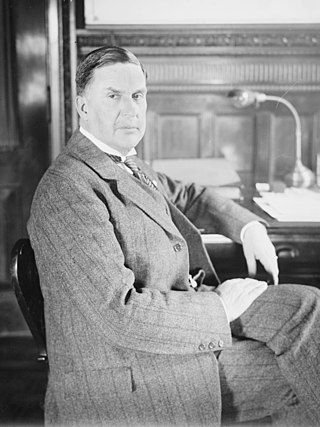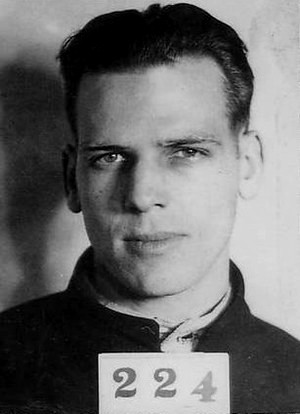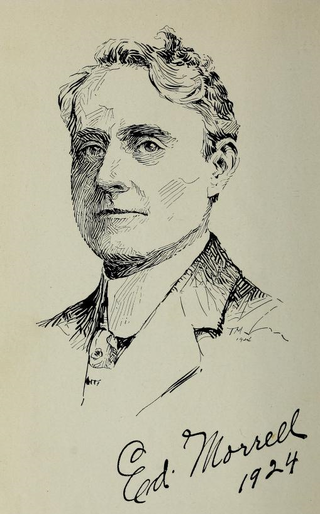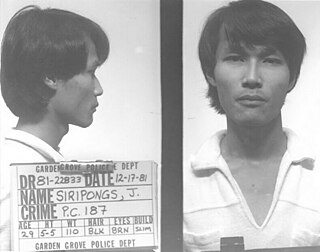Biography
Early life
Charles Donald Lowrie was born in Pennsylvania on March 26, 1875. [2] [3] Accounts of Lowrie's life prior to imprisonment are scarce; he held various jobs ranging from bookkeeping and stenography to working as a traveling salesman. [4]
Eventually, Lowrie was out of money and without shelter. After three days, Lowrie had exhausted his resources in looking for work and determined that either suicide or crime was the only way out. Having a nickel in his pocket, he decided to flip a coin. If tails, Lowrie, living in San Francisco at the time, would throw himself into the San Francisco Bay; if heads, Lowrie would commit a crime. [4] The coin turned heads and two hours later Lowrie found himself entering the house of a well-to-do family, stealing a sleeping man's watch and a purse containing sixty dollars. Within a short time, Lowrie was arrested for burglary and sent to jail. [4]
Conviction and imprisonment
Convicted of burglary, Lowrie was sentenced to fifteen years in San Quentin State Prison, where he remained for ten years until his early release on good behavior in 1911. [4] Another five years of parole ahead, Lowrie started to write down his prison story under the auspices of the San Francisco Bulletin . [5]
Literary works
Lowrie's best known literary work, My Life in Prison, was published in 1912. Stories in the book were not self-glorifying but rather plain and descriptive accounts of life in prison. Lowrie's simple writing style helped in obtaining confidence and understanding among his audience. The portrayal of the desolate and humiliating conditions prisoners had to face at the time was a central theme. [4]
In 1912, Lowrie also joined the lecture circuit, traveling from community to community and talking about his life in prison. [6]
My Life Out of Prison was Lowrie's sequel, published in 1915, describing his struggle to readjust after being released from prison. [5]
With his writings, Lowrie is said to have inspired Thomas Mott Osborne, an industrialist from New York, in prison reform work. During Osborne's wardenship at the Sing Sing Correctional Facility, Lowrie even visited and helped institute new methods. [1]
His writings are also said to have been one of the causes of capital punishment laws of the time being repealed. In addition, a bureau for the relief and guidance of ex-convicts was opened at his suggestion. Lowrie persistently voiced his dissatisfaction with the existing system of punishment. According to him, "punishment was [not] a discovered cure for human weakness." [5]
Family
On December 4, 1917, Lowrie married twenty-five-year-old Mildred Irene Dean in Brooklyn, New York. [7] Mildred Lowrie, a native of Danbury, Connecticut, bore him one son, Charles Donald Lowrie, Jr. (1918–1957). [8]
Death and legacy
After serving a few months for another burglary conviction, Lowrie was released on parole from Arizona Penitentiary. Two weeks later, on June 24, 1925, he died at the Phoenix, AZ home of a local architect, R. B. Dick Redington, who housed him at the time. [1] [9]
With My Life in Prison, Lowrie defined a new category of writing which tried to make a connection between the failure of individuals and their social class, thereby presaging some of the writings of black radicals of the 1960s and 1970s. [10]
Life imprisonment is any sentence of imprisonment for a crime under which convicted criminals are to remain in prison for the rest of their natural lives. Crimes that warrant life imprisonment are extremely serious and usually violent. Examples of these crimes are murder, torture, terrorism, child abuse resulting in death, rape, espionage, treason, illegal drug trade, human trafficking, severe fraud and financial crimes, aggravated property damage, arson, hate crime, kidnapping, burglary, robbery, theft, piracy, aircraft hijacking, and genocide.

Sing Sing Correctional Facility, formerly Ossining Correctional Facility, is a maximum-security prison operated by the New York State Department of Corrections and Community Supervision in the village of Ossining, New York, United States. It is about 30 miles (48 km) north of Midtown Manhattan on the east bank of the Hudson River. It holds about 1,700 inmates and housed the execution chamber for the State of New York until the abolition of capital punishment in New York in 1977.

San Quentin Rehabilitation Center (SQ), formerly known as San Quentin State Prison, is a California Department of Corrections and Rehabilitation state prison for men, located north of San Francisco in the unincorporated place of San Quentin in Marin County.
In the United States, habitual offender laws have been implemented since at least 1952, and are part of the United States Justice Department's Anti-Violence Strategy. These laws require a person who is convicted of an offense and who has one or two other previous serious convictions to serve a mandatory life sentence in prison, with or without parole depending on the jurisdiction. The purpose of the laws is to drastically increase the punishment of those who continue to commit offenses after being convicted of one or two serious crimes.

Thomas Mott Osborne was an American prison officer, prison reformer, industrialist and New York State political reformer. In an assessment of Osborne's life, a New York Times book reviewer wrote: "His career as a penologist was short, but in the interval of the few years he served he succeeded in revolutionizing American prison reform, if not always in fact, then in awakening responsibility.... He was made of the spectacular stuff of martyrs, to many people perhaps ridiculous, but to those whose lives his theories most closely touched, inspiring and often godlike."
Capital punishment was abolished in 2019 in New Hampshire for persons convicted of capital murder. It remains a legal penalty for crimes committed prior to May 30, 2019.

Clarence Ray Allen was an American criminal and proxy killer who was executed in 2006 at the age of 76 by lethal injection at San Quentin State Prison in California for the murders of three people. Allen was the second-oldest inmate at the time to be executed in the United States since 1976.

California Medical Facility (CMF) is a male-only state prison medical facility located in the city of Vacaville, Solano County, California. It is older than California State Prison, Solano, the other state prison in Vacaville.

Oregon State Penitentiary (OSP), also known as Oregon State Prison, is a maximum security prison in the northwest United States in Salem, Oregon. Originally opened in Portland 173 years ago in 1851, it relocated to Salem fifteen years later. The 2,242-capacity prison is the oldest in the state; the all-male facility is operated by the Oregon Department of Corrections (ODOC). OSP contains an intensive management wing, which is being transformed into a psychiatric facility for mentally ill prisoners throughout Oregon.
American prison literature is literature written by Americans who are incarcerated. It is a distinct literary phenomenon that is increasingly studied as such by academics.

James Crittenton Lucas was an American criminal who served a life sentence in Alcatraz. He is best known for being part of an attempted escape from Alcatraz Penitentiary in 1938, and for attacking Al Capone in the prison's laundry room on June 23, 1936.
In the United States, life imprisonment is the most severe punishment provided by law in states with no valid capital punishment statute, and second-most in those with a valid statute. According to a 2013 study, 1 of every 2 000 inhabitants of the U.S. were imprisoned for life as of 2012.
The San Quentin Six were six inmates at San Quentin State Prison in the U.S. state of California who were charged with actions related to an August 21, 1971 escape attempt that resulted in six deaths and at least two people seriously wounded. The San Quentin Six were Fleeta Drumgo, David Johnson, Hugo Pinell, Johnny Larry Spain, Willie Tate, and Luis Talamantez. The dead included George Jackson, a co-founder of the Black Guerrilla Family; two other inmates, and three guards.
Graham v. Florida, 560 U.S. 48 (2010), was a decision by the Supreme Court of the United States holding that juvenile offenders cannot be sentenced to life imprisonment without parole for non-homicide offenses.

Edward H. Morrell was an American convict, activist and a writer.
Rufus William Franklin (1916–1975) was an American criminal who served a life sentence in Alcatraz. He is best known for taking part in the third documented attempted escape from Alcatraz Prison with Thomas R. Limerick and James C. Lucas on the night of May 23, 1938.

Kevin "Rashid" Johnson is a revolutionary, writer, artist, social activist, founding member of the New Afrikan Black Panther Party, founding member of the Revolutionary Intercommunal Black Panther Party, member of the Incarcerated Workers Organizing Committee, and prisoner in the Ohio Department of Rehabilitation and Correction.

Jaturun Siripongs was a Thai national who was executed by the state of California for the December 1981 murders of two people during a robbery in Garden Grove, California. Siripongs maintained that he was involved in the robbery but was not the actual killer. Ultimately, he was convicted and sentenced to death in 1983 and was subsequently executed in 1999 at San Quentin State Prison by lethal injection.

Victor Folke Nelson was a Swedish-American writer, prisoner, and prison reform advocate. He spent many years incarcerated in both the New York and Massachusetts prison systems and came to the attention of neurologist Abraham Myerson and penologist Thomas Mott Osborne for his potential as a writer. In 1932, Nelson published his book Prison Days and Nights with the assistance of Dr. Myerson.

Society and Prisons: Some Suggestions for a New Penology is a book by Thomas Mott Osborne that was first published in 1916 by Yale University Press. In this book, Osborne describes the state of the prison system in the United States and proposes recommendations for prison reform. Drawing on his personal experience as a voluntary prisoner, he discusses the purpose of incarceration, treatment of inmates, and the potential for rehabilitation. The book influenced the discussion of prison reform and contributed to a change in societal perceptions of incarcerated individuals.












